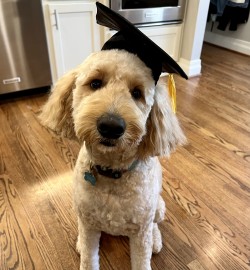The furry graduate
Our 18-year-old son wasn’t the only family member who graduated this spring. But instead of a fancy diploma, the other “kid” got a Milk-Bone. He didn’t mind a bit.
Our 15-year-old daughter, Kate, has a dog named Mac who came to live with us in February of last year. The 7-month-old goldendoodle showed the potential to become a service dog who could respond to Kate’s seizures and even detect an approaching seizure by scent. But first, he had to go to school.
Because we were still neck-deep in the pandemic at that time, Kate and Mac attended service dog school via Zoom online training sessions. At least once every two weeks, we went online to meet with a dog trainer in Indianapolis whose agency specializes in seizure service dogs.
The classroom was our living room. We’d point a laptop camera toward Kate and Mac so the trainer could give instructions and see them learn and practice the steps involved in each task.
How do you get a dog to learn all these new skills? He or she has to be what the trainers call “highly food motivated.” Lucky for us, Mac never met a treat he didn’t like. He has his favorites, of course. Mac could probably be taught to prepare our tax returns if we just give him enough chunks of cheese or hotdogs.
But for now, we’re sticking to the service dog “must-have” list. First on that list is manners. Service dogs are legally allowed to go almost anywhere their handlers go, so it’s important for them to be professionals when they’re on the job. Thanks to the training, most service dogs have quite a bit more self-control and obedience than your average toddler.
Here’s a list of other things service dogs are trained to do: exit a car in an orderly way, walk into and navigate stores and public spaces while on a leash, sit and lie down on command, wait calmly under a table while at a restaurant, ignore food dropped by people nearby, sit and stay on command and then walk to their handler when called, remain under control even if the leash is dropped, and tolerate loud noises.
Just like human students, service dogs have homework. Kate and Mac did much of their homework at a Home Depot not far from our house. It’s a dog-friendly spot that offers plenty of room for dogs to learn how to walk calmly in public while seeing lots of different people as well as other dogs.
Depending on what type of service dog a person needs, trainers also teach dogs to do specific tasks to help manage an illness or chronic condition. For example, Mac has learned to lie down next to Kate if she has a seizure that makes her fall. He has learned to press a button that would call me and her dad if she were to have a seizure while alone in a room. When he hears a phone alarm telling us it’s time for Kate to take her medicine, Mac can nudge her arm and bug her until she remembers to take the pills. If she feels anxious or panicky, Mac is the first one to notice and calm her down.
Our furry graduate has been with Kate at doctor appointments, hotels, restaurants, amusement parks, school field trips, shopping malls, high school and even a night of dinner theatre. One of our favorite things about having him with us is how people light up and smile when they see a dog in an unexpected place. His toothy, goofy grin doles out a dose of happiness everywhere he goes.
And for Kate, who is learning to navigate an illness while leading as normal a life as possible, he is a constant comfort and layer of added protection. Watching the bond between the two of them grow during this past year has convinced me that sometimes a person’s guardian angel shows up on four legs with a wagging tail. Pass the Milk-Bones.
Gwen Rockwood is a syndicated freelance columnist. Email her at gwenrockwood5@gmail.com. Her book is available on Amazon.
